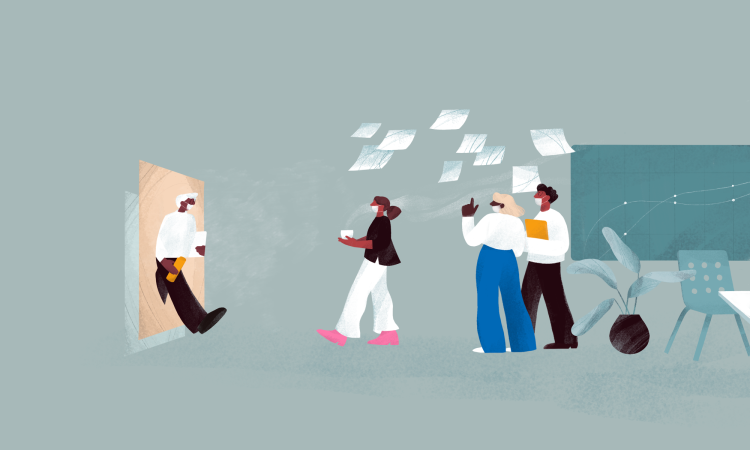
This post is part of TED’s “How to Be a Better Human” series, each of which contains a piece of helpful advice from people in the TED community; browse through all the posts here.
Our working situations have changed dramatically since early 2020. The COVID-19 pandemic caused many people to lose their jobs, and companies around the world made the move to remote work. For example, by June 2020, 42 percent of the US labor force were working from home, and 46 percent of employees in London reported working from home at some point in 2020. Over the past year, we’ve nailed the bed-to-Zoom commute: We can be up, presentably dressed (our top half at least), hydrated, caffeinated and in front of the screen in minutes.
Despite the challenges of making our living space into our working space, we’ve gotten used to the comforts of working from home, and surveys show that employees are feeling anxious about returning to the office. As vaccination rates rise and COVID cases drop, more of us are being asked to go back to in-person workplaces. So how can we make this transition easier?
Here are 6 tips for returning:
1. Be compassionate with yourself, and others
The shift to home working was sudden, and that kind of change was psychologically jarring and therefore negative for most people, according to Meag-gan O’Reilly PhD, a psychologist at Stanford, cofounder of Inherent Value Psychology Inc. What’s more, this shift was combined with uncertainty about the future; the loss of autonomy, freedom and connection that came with lockdown; and a level of loss and grief that was unprecedented for many of us.
Being at home all the time and losing familiar structures and routines led some of us to overwork — which might have included taking up new hobbies with overly high expectations — while others struggled to focus. “If you pride yourself on having a good work ethic, that may have hit your sense of self and self-esteem,” O’Reilly says. “I think people were unfairly blaming themselves for struggling. When you’re going through something unprecedented, there’s no bar for this.”
The pandemic also highlighted existing inequalities. O’Reilly asks: “Who was getting the virus more? Black and brown communities, because they’re more likely to be essential workers that deal with people. So for people who are Black and brown, we had to sit and hold and deal with this history and this very present racism, sexism and classism.” At the same time, the murder of George Floyd and continued episodes of police brutality brought grief and trauma to the fore for so many and contributed to feelings of discomfort or othering at work, based upon how employers responded to the movement for Black lives.
Consider the things that have changed for you this year and decide what elements you want to keep.
Besides these huge societal issues were the minutiae — the cancelled holidays, birthdays over Zoom instead of in person, not being able to hug loved ones or even stop by a coworker’s desk to say “hello” in the morning. We lost or had to adjust the little daily routines that make up our lives, and as many of us are exiting crisis mode, it’s time to take stock of both what your life is like now and what it used to be like.
O’Reilly says it’s important to acknowledge the journey you’ve been on in the past 20 months and give yourself compassion and empathy. Consider the things that have changed for you this year, and decide what elements you want to keep.
“One of the elements I hope all of us keep as we return to work is this idea of shared humanity,” she says. “When we were all Zooming in, we had kids running in the background, our pets jumping up on our laps. People got to see us as more fully human, and that allowed everyone else to give more grace.”
2. Be intentional with your time and energy, and set realistic expectations
If a commute is part of your return to the office, your time is likely to be squeezed during this transition. “We need to accept that we can’t show up everywhere,” O’Reilly says. “Stretching and hustling and trying to be everywhere is not only futile, but it’s exhausting. And it’s trying to solve the wrong problem.”
Instead, she encourages people to think about what projects, teams, activities and individuals they want to be more connected with. How can you show up where you want to be? How are you going to distribute your finite energy and time intentionally? Are there certain things you’ve invested time or energy in that you want to continue? Or leave behind?
If you’re preparing to return to in-person work, you need to understand what it will look like. Companies are taking different approaches, but one thing’s certain, says US-based Rebecca Henderson, CEO of Randstad Global Businesses, which provides HR services. “We’re not going back to what it was pre-pandemic. There are going to be limitations on how people will be getting together.” This could mean that lunch break spaces, meeting rooms and even restrooms may look very different than before.
Another important consideration is vaccination. Not everyone will choose to be vaccinated, and companies will need to decide how to approach this. Get to know the reality you’re heading back into. What are the rules where you work? Are you comfortable with the safety measures your employer has established? Ask questions, and read the information provided by your workplace. Then imagine the situation and give yourself time to adjust to it mentally.
3. Establish a new routine (and wake up early enough to do it!)
Working from home, you’ve probably mastered the art of hopping on Zoom at the last minute. The thought of a morning routine might seem like a distant memory.
Think about how you can bridge your current routine with the one you need. Figure out what time you need to wake up and what support you might need at home. “Start thinking about building in small pieces of the routine into your current schedule, so you can scaffold up to what you’re going to need to do,” explains O’Reilly.
Reawaken old habits. Give yourself time to prepare meals if you need to bring lunch to work, or to pick out and iron the work clothes that haven’t left your closet in so long.
This shift back to the office gives you the chance to set your boundaries in terms of availability, communication, and when and where you work.
There could also be new layers of routine during your working day. Perhaps you have to book a particular time slot or day to work in the office, take an extra few minutes to sign in to your building in the morning or undertake a health screening.
And if your workplace is taking a staggered approach to staffing, you might need to plan ahead to make sure you get the benefits of socializing again. Try to coordinate with someone you usually work with, Henderson says. “I really encourage folks to have a routine – a well-defined schedule that you potentially match up with your colleagues. Otherwise, you run the risk of going back to the office but still feeling alone.”
4. Set your boundaries
Working from home blurred a lot of boundaries. When you’re sitting at a makeshift desk in your bedroom or kitchen, it can be almost impossible to separate work from home. “You could be having dinner with your family, yet you’re still working,” says O’Reilly. “You’re more accessible – people can email you anytime, so the boundary gets lost.”
This shift back to the office gives you the chance to set your boundaries in terms of availability, communication and when and where you work. Do you want to turn off your emails at certain times? Do you prefer to communicate by Slack or video call? Are weekly check-in meetings most effective? Think about what works best for your productivity and your mental health, and share these findings with your employer and colleagues.
Suddenly being around a lot of people again could come as a shock to the system.
You may feel that you work better from home. Employers are open to different approaches, and this can make it easier for you to establish new boundaries. According to a report by the Welsh Government, working from home is a trend that has been increasing since 1981 in the UK, reaching a maximum of 43.1 percent of employees in April 2020. The Work After Lockdown research project suggests it won’t be entirely reversed.
“For sure, employers have changed their attitude about productivity at home,” Henderson says. “For many years, a lot of employers didn’t like the work from home scenario because they didn’t feel like they could get their hands on productivity metrics. I don’t believe there are any employers who believe that any longer.”
You might also want to think about your sensory boundaries as you return to a crowded office. Suddenly being around a lot of people again could come as a shock to the system. If it’s not possible to return to work in phases, O’Reilly recommends getting away from the screen regularly. “Inject some ‘admin time’ into the day, and instead of catching up on paperwork, have a sensory break,” says O’Reilly. “Step outside, and close your eyes. Do some breathing or stretching, or engage in some meditation.”
5. When you reconnect with people, remember they’ve also been through a lot
Socializing is an important aspect of work, but it’s a big source of anxiety for many. After more than a year conversing with colleagues through screens, you may be worried about being socially awkward. Practice can help here: Go out, talk to people at the store or in the street, and start brushing up on your small talk. Treat yourself with kindness, and take it slowly.
Your colleagues may have lost someone, or seen a family member become disabled because of long COVID.
Then there’s the physical aspect: We need to think about hugs versus elbow bumps, and consider people’s differing levels of comfort with contact. “There need to be conversations around how people want to reconnect, how much or how little, and all that can be daunting for people,” O’Reilly says.
Everyone has experienced the pandemic differently, and some are excited to return to work. So how can you handle this when you’re anxious? In O’Reilly’s opinion, someone who is already struggling shouldn’t have to constantly advocate for themselves, and this is why a compassionate workplace is essential. But sometimes it may be necessary to make yourself heard and speak up for what you require. Those who are excited should be mindful, ask questions and make space for people who are anxious.
No matter where you are on the excitement spectrum, keep in mind what people have been through. Your colleagues may have lost someone or seen a family member become disabled because of long COVID, or they themselves may be struggling with recovery in ways that are invisible. “Take some time to check in and calibrate with people, because that’s going to show up in their work life in some way,” O’Reilly says. “Some people aren’t going to be happy, some people are still grieving, and some people are still losing people. Let’s not forget that.”
Plus: Be mindful of wider issues that have come to the fore during the pandemic. Many of O’Reilly’s private practice clients are Black, Indigenous and people of color (BIPOC), and some of them experienced a reprieve by not being in the office. “They dealt with fewer microaggressions and less toxic culture, especially as police violence, Black Lives Matter and the loss of Black lives was in the news. They didn’t have to go to work and answer questions in person. They had that digital distance that gave them a little privacy.”
There are things you can do to be more aware and compassionate about the experience of your BIPOC colleagues, O’Reilly says. “First, remember Black Lives Still Matter. Second, check in but do not demand or expect to be let into someone’s process. Just leave them an open invitation. And third, continue doing your work as an ally. Be on the lookout for microaggressions, emotional labor and when your BIPOC peers are being dismissed or treated inequitably.”
When we ask our peers and coworkers how the pandemic was, we should include racial trauma.
She also urges people to remember that during the COVID-19 pandemic, there was also many incidences of police violence that traumatized people in the Black community. “When we ask our peers and coworkers how the pandemic was, we should include racial trauma. You could say something like ‘COVID is hard. When you’re ready or want to share, I also want to know how all the loss and racial trauma is for you.’”
6. Prepare to take care of your mental health
It’s totally normal to plan for anxiety — after all, we do this all the time for big, anxiety-provoking events like weddings and births. O’Reilly recommends following three steps: Pin down a date to return to the office, have an internal conversation about how you’re feeling, and talk to people about it. “Free-floating anxiety is worse than specific worries,” O’Reilly says. “Having an anchor date is grounding, so it’s not sudden or unknown. Asking yourself questions helps you attend to your feelings and adapt to the stressors.”
For example, if you identify that you’re anxious about attending a meeting, this might mean planning to sit at the back of the room. Talking to others — gathering a community — will give you support for managing your anxiety. But O’Reilly says it can go much further. “I think mental health got a big spotlight during this pandemic, finally, in a way that wasn’t as stigmatized, because we were all going through it,” she says. “I want people to know they’re not the only ones. We always do better when we don’t feel alone.”
Watch Dr. Meag-gan O’Reilly’s TEDxSJSU Talk here:














